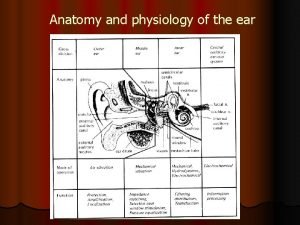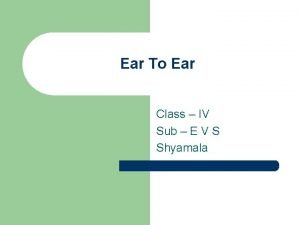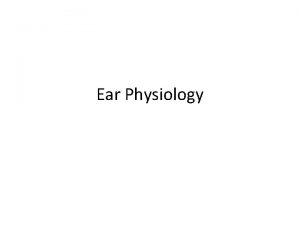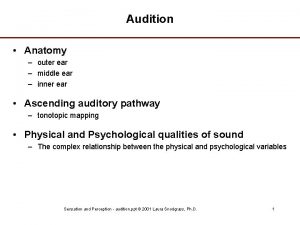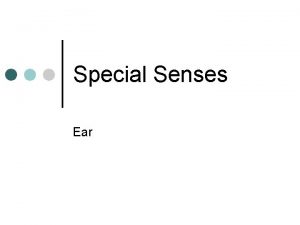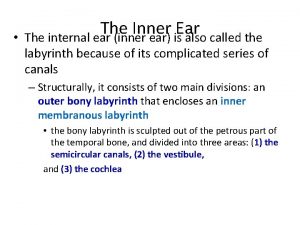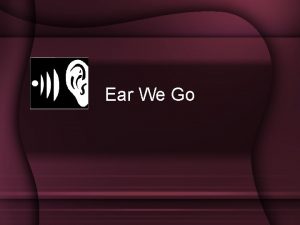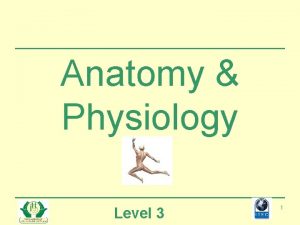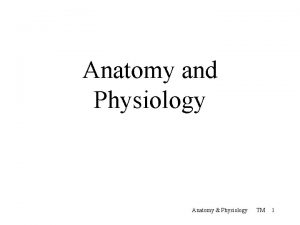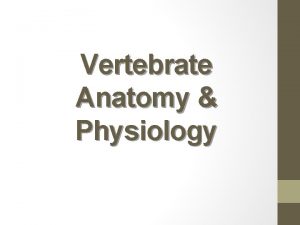Ear I Anatomy and Physiology of the ear









































- Slides: 41

( Ear I ) Anatomy and Physiology of the ear Dr. Farid Alzhrani Assistant professor Consultant of Otolaryngology, head and neck surgery King Abdulaziz University Hospital

ANATOMY OF THE EAR

A) External Ear Auricle External Canal

The Auricle:

The External Auditory Canal :

The External Auditory Canal :

Nerve Supply of External Ear • Cervical II & III ( greater auricular and lesser occipital) • V cranial nerve (auriculotemporal) • X cranial nerve (auricular or Arnold’s) • Fibres from VII cranial nerve

TYMPANIC MEMBRANE • It forms the partition between the external auditory canal and the middle ear. • Parts : 1. Pars Tensa. 2. Pars Flaccida.

TYMPANIC MEMBRANE The Tympanic membrane consist of three layers: 1. Outer layer, of epithelial (ectodermal) origin, 2. The middle layer or lamina propria, of mesodermal origin, 3. The inner layer, of endodermal origin, comprising the middle ear mucosa.

TYMPANIC MEMBRANE

TYMPANIC MEMBRANE

ANATOMY OF THE EAR a) External Ear b) Middle Ear c) Inner Ear

B) Middle Ear 1. Eustachian (Pharyngo-tympanic) Tube 2. Tympanum (Middle Ear Cavity) 3. Mastoid Antrum and Air Cells

Middle Ear Eustachian (Pharyngo-Tympanic) Tube • Connect the middle ear cavity with nasopharynx. • Lies adjacent to the ICA

Middle Ear Eustachian (Pharyngo-Tympanic) Tube

Middle Ear Eustachian (Pharyngo-Tympanic) Tube

Middle Ear Eustachian (Pharyngo-Tympanic) Tube

Middle Ear Eustachian (Pharyngo-Tympanic) Tube

Middle Ear Tympanic cavity (Middle ear cavity)

Middle Ear Tympanic cavity (Middle ear cavity)

Middle Ear Tympanic cavity (Middle ear cavity) Middle ear cavity divided into three parts

Middle Ear Tympanic cavity (Middle ear cavity) LINING OF THE MIDDLE EAR : Mucous membrane of the middle ear space consists of stratified cuboidal epithelium, which changes to pseudostratified ciliated epithelium around the mouth of the eustachian tube.

Middle Ear Tympanic cavity (Middle ear cavity) Motor nerve supply of the Sensory nerve supply of the middle ear mucosa : middle ear muscles : 1. Tympanic branch of the glossopharyngeal nerve. 2. Auriculotemporal branch of the trigeminal nerve. 1. Stapedius muscle supplied by the stapedial branch of the facial nerve. 2. Tensor tympani muscle supplied by the mandibular division of the trigeminal nerve.

Middle Ear Mastoid antrum and air cells Air-containing cells of the mastoid process are continuous with the air in the middle ear.

Middle Ear Mastoid and air cellsthe sixth • Pneumatization is antrum complete between and twelfth years of life. • Normal tubal function is a prerequisite for biologically active, healthy middle ear mucosa, and thus for the normal process of pneumatization.

ANATOMY OF THE EAR a) External Ear b) Middle Ear Cleft c) Inner Ear

C) Inner Ear Consists of : 1. Labyrinth. • • Bony Labyrinth Membranous Labyrinth 2. Internal Auditory Canal.

Inner Ear Bony Labyrinth v Its parts : 1. Bony Cochlea 2. Vestibule 3. Bony semicircular canals

Inner Ear Bony Labyrinth v Its contents : 1. Perilymph 2. Membranous labyrinth

Inner Ear Membranous Labyrinth v Its parts : 1. Cochlear duct 2. Saccule and utricle 3. Membranous semicircular ducts

Inner Ear Membranous Labyrinth v Its contents : 1. Endolymph 2. Sensory epithelium – Cochlea: organ of Corti – Utricle & saccule: maculae – Semicircular canals: cristae

Inner Ear Internal Auditory Canal Contains: • Cochleovetibular nerve • Facial nerve

Inner Ear Internal Auditory Canal

Inner Ear Internal Auditory Canal CENTRAL CONNECTIONS OF COCHLEAR NERVE

PHYSIOLOGY OF THE EAR

FUNCIONS OF THE EXTERNAL EAR • Protection of the middle ear – Curvature – Cerumen • Auditory functions: – Sound conduction – Increase sound pressure by the resonance function

FUNCTIONS OF THE EUSTACHIAN TUBE Protection Ventilation Drainage

FUNCIONS OF THE MIDDLE EAR • Conduction of sound • Protection to the inner ear – stapedial reflex

FUNCIONS OF THE INNER EAR • Hearing Function: – Transduction of sound to action potentials • Vestibular Function: – Participate in maintaining body balance

Hearing Function:

Thank you
 Physiology of external ear
Physiology of external ear Animals whose ears can be seen
Animals whose ears can be seen Animals whose ears cannot see
Animals whose ears cannot see Respiratory
Respiratory Tattoo anatomy and physiology
Tattoo anatomy and physiology Science olympiad anatomy and physiology
Science olympiad anatomy and physiology Crown plants examples
Crown plants examples Anatomy and physiology bones
Anatomy and physiology bones Peptic ulcer anatomy
Peptic ulcer anatomy Liver anatomy
Liver anatomy Epigastric region
Epigastric region Difference between anatomy and physiology
Difference between anatomy and physiology Straw coloured fluid
Straw coloured fluid Chapter 14 anatomy and physiology
Chapter 14 anatomy and physiology Human anatomy and physiology seventh edition marieb
Human anatomy and physiology seventh edition marieb Http://anatomy and physiology
Http://anatomy and physiology Waistline
Waistline Anatomy and physiology of appendix
Anatomy and physiology of appendix Aohs foundations of anatomy and physiology 1
Aohs foundations of anatomy and physiology 1 Aohs foundations of anatomy and physiology 2
Aohs foundations of anatomy and physiology 2 Anatomy and physiology of swine
Anatomy and physiology of swine Anatomy and physiology chapter 8 special senses
Anatomy and physiology chapter 8 special senses Chapter 13 anatomy and physiology of pregnancy
Chapter 13 anatomy and physiology of pregnancy Unit 26 self evaluation answers
Unit 26 self evaluation answers Science olympiad forensics cheat sheet
Science olympiad forensics cheat sheet Chapter 2 basic chemistry anatomy and physiology
Chapter 2 basic chemistry anatomy and physiology Physiology of stomach ppt
Physiology of stomach ppt Anatomy and physiology of pancreas
Anatomy and physiology of pancreas Chapter 7 anatomy and physiology
Chapter 7 anatomy and physiology Anatomy and physiology coloring workbook chapter 14
Anatomy and physiology coloring workbook chapter 14 Chapter 10 blood anatomy and physiology
Chapter 10 blood anatomy and physiology Aohs foundations of anatomy and physiology 1
Aohs foundations of anatomy and physiology 1 Aohs foundations of anatomy and physiology 1
Aohs foundations of anatomy and physiology 1 Anatomy and physiology
Anatomy and physiology Anatomy and physiology chapter 15
Anatomy and physiology chapter 15 Cornell notes for anatomy and physiology
Cornell notes for anatomy and physiology Anatomy and physiology edition 9
Anatomy and physiology edition 9 Necessary life functions anatomy and physiology
Necessary life functions anatomy and physiology Holes anatomy and physiology chapter 1
Holes anatomy and physiology chapter 1 Holes essential of human anatomy and physiology
Holes essential of human anatomy and physiology Anatomy and physiology unit 7 cardiovascular system
Anatomy and physiology unit 7 cardiovascular system Gi tract histology
Gi tract histology
